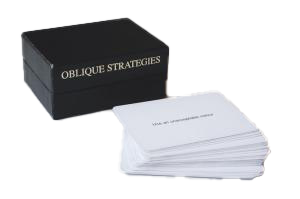A Counterintuitive Path to Innovative Solutions
Whether you’re facing a thorny technical issue or a complex business challenge, sometimes the most direct path forward isn’t the best approach. Truly innovative solutions often emerge when you embrace the chaos and messiness of a problem.
Imagine you’re part of a team stuck in an endless cycle of debate, with no clear “right” answer. Some members want to barrel ahead, others shut down every idea proposed. The conflict and lack of alignment can quickly turn frustrating. (For more, see Kantor Four Player Model)
Rather than forcing a consensus, consider the powerful technique of injecting obliqueness. Legendary producer Brian Eno describes this as adopting different vantage points – “tangential ways of attacking problems that were in many senses more interesting than the direct head-on approach.”
Solving Complex Problems with Oblique Strategies
 Eno created a deck of “Oblique Strategies” cards with prompts like “Work at a different speed” or “Look at the ins and outs of things.” The goal was to disrupt typical patterns of thinking that can lead to creative ruts.
Eno created a deck of “Oblique Strategies” cards with prompts like “Work at a different speed” or “Look at the ins and outs of things.” The goal was to disrupt typical patterns of thinking that can lead to creative ruts.
A simple exercise in oblique thinking is to reframe the situation through contrasting lenses. For example:
- “What would the ‘best’ solution look like? What about the ‘worst’?”
There’s an almost inexhaustible list of such value pairs.
- simple/complicated
- easy/difficult
- nothing/anything
- random/deliberate
- quick/slow
For more ideas, browse the following:
- Oblique Strategies Online
- On your iPhone / Apple Watch
- “Over One Hundred Worthwhile Dilemmas” In your hands
To stimulate divergent thinking, “pick a card, any card” and have folks generate thought experiments. (See Note and Vote / Nominal Group Technique)
By considering extreme or unconventional perspectives, new paths will emerge from the chaos.
The Transformative Power of Messiness
 In a TED talk “How Frustration Can Make Us More Creative”1 Tim Harford shares a captivating story about pianist Keith Jarrett’s legendary performance at the Cologne Opera House in 1975. Upon arriving at the venue, Jarrett was dismayed to find the piano in terrible “unplayable” condition. But he decided to “embrace the mistake” and ended up playing one of the most celebrated improvised concerts of all time.
In a TED talk “How Frustration Can Make Us More Creative”1 Tim Harford shares a captivating story about pianist Keith Jarrett’s legendary performance at the Cologne Opera House in 1975. Upon arriving at the venue, Jarrett was dismayed to find the piano in terrible “unplayable” condition. But he decided to “embrace the mistake” and ended up playing one of the most celebrated improvised concerts of all time.
Harford uses this narrative as a springboard to explore broader themes about creativity and problem-solving. Citing examples from cognitive psychology, complexity science, and social psychology he illustrates how obstacles can inadvertently spark creativity if we resist our instinct to fight or prevent “messes.” As Harford states, “You add a little randomness, unpredictability very early on in the process…and that tends to make the problem-solving process better.”
Unlocking Extraordinary Outcomes
More on Oblique Strategies
- Thanks, Voranc Kutnik for sharing this video link way back when [↩]

